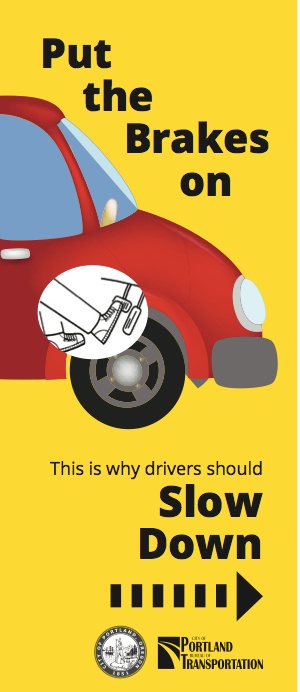
It’s a sad fact that too many people are killed while walking on Portland streets. Despite having some of the safest roads in the country, we still lose too many of our fellow citizens this way. Recently, these troubling tragedies have caused advocates to sound the alarm and local electeds to use “improving pedestrian safety” as a rallying cry in their effort to raise new local transportation revenue.
Another way our city has reacted is with a new marketing campaign aimed at addressing some of the root causes of these collisions: speed and road user behavior. The other day I cam across a new promotional ad created by PBOT with the goal of getting people to slow down and be more aware when using the streets.
The main title of the piece is “Put the brakes on: This is why drivers should slow down.” The ad also shares the infamous “speed kills” graphic that lays out how an even 10 mph difference can mean life or death. The bulk of the piece focused on tips for walkers — with a list of seven tips translated into eight different languages.
Sharon White, a traffic safety specialist at PBOT who works on the High Crash Corridor program (among other things), said the “Put the brakes on Pedestrian Deaths” ad campaign is being inserted into high school newspapers. Specifically, PBOT has placed the graphic in two schools located close to SE Powell Blvd, one of the most dangerous streets in Portland: the Franklin High School Post and the Cleveland High School Clarion.
The ad is also being placed in the SW Portland Post (which is distributed to homes and businesses near SW Barbur Blvd and SW Beaverton-Hillsdale Highway, two of PBOT’s High Crash Corridors), the East Portland News, and the SW News.
Here are a few details from the poster and brochure:
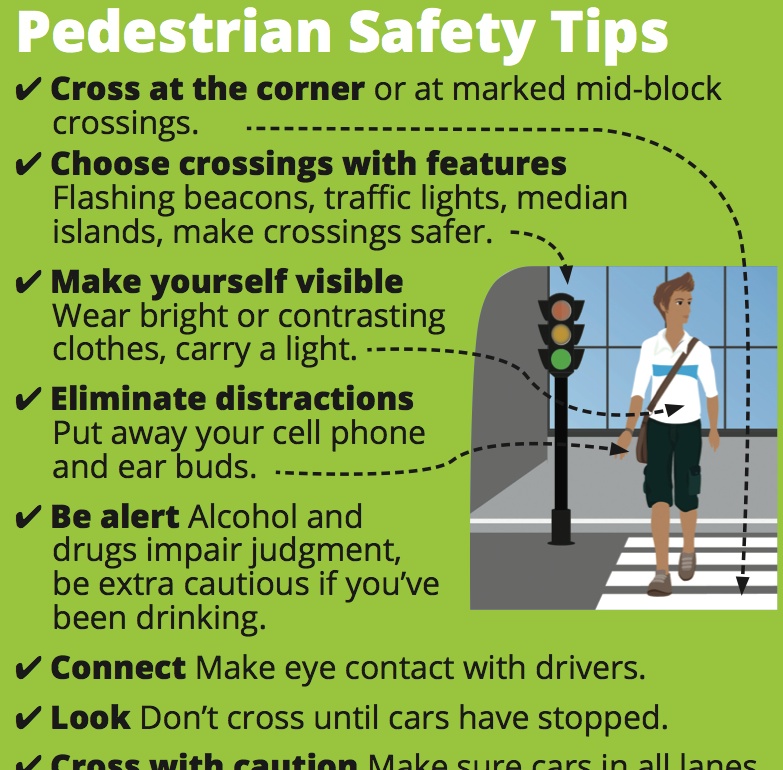
Advertisement
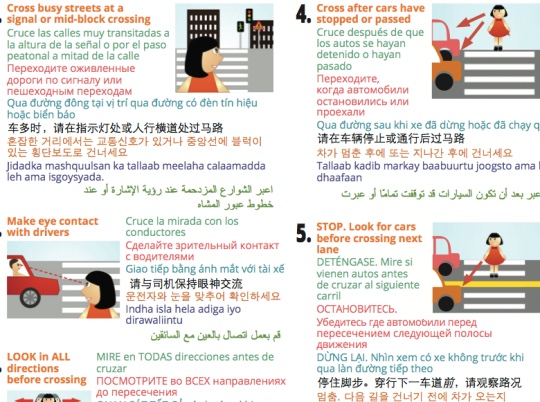
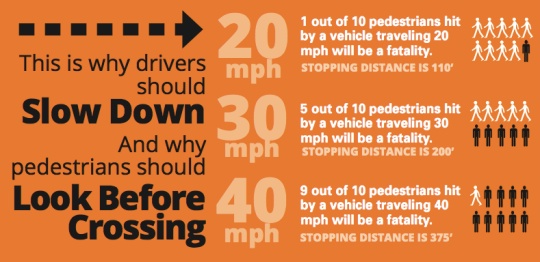
Funding for this campaign came from the Oregon Department of Transportation and NHTSA’s Federal Safe Community Grant program.
Another element of this campaign is an online “Pedestrian Safety Quiz” available at LookBeforeCrossing.org. PBOT is offering a free reflective tote bag for Portlanders who complete the quiz.
Most of the talk around walking safety revolves around infrastructure — building new sidewalks and crossing treatments — so it’s great that PBOT hasn’t forgotten the marketing side of the equation. And while I’d personally like to see more emphasis on how to drive safely (since that’s very often the cause of these collisions) it’s good to see PBOT embrace campaigns like this.
To learn more about PBOT’s traffic safety work and programs, see their website.


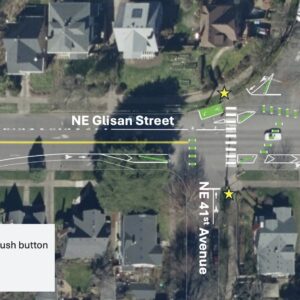

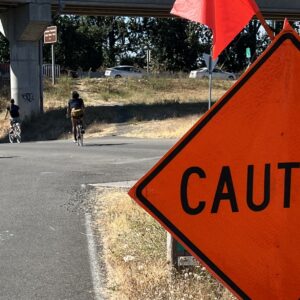
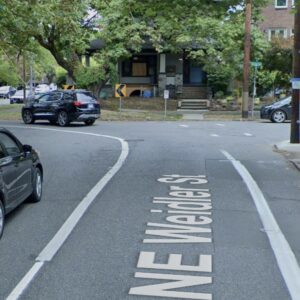
Thanks for reading.
BikePortland has served this community with independent community journalism since 2005. We rely on subscriptions from readers like you to survive. Your financial support is vital in keeping this valuable resource alive and well.
Please subscribe today to strengthen and expand our work.
It’s good to see a public campaign, yes, but I cringe that it’s focused almost entirely on what a pedestrian should do. Wear bright clothes? Seriously? Sounds like something from ODOT, not PBOT.
Unless it’s followed up with a campaign for drivers — that can be read at high speeds from inside their car — this one has little cred. Especially when we’re talking about deaths on SE Powell.
no contrasting clothing is a common listed issue with pedestrian deaths at night time.
I’m sure it is listed. But that tells us nothing useful except that–as with the ubiquitous ‘was he wearing a helmet?’ fixation–this redirects our attention to the victim rather than the perpetrator.
I’ve mentioned several times in past conversations about the wear-reflective-clothes campaigns that are so popular here that German and Austrian law and outreach on this issue focuses on the drivers, on headlight technology, on appropriate speed. Fault in cases where a pedestrian is hit by someone driving is assumed to be with the person driving, or shared, even in cases where we would assume otherwise: drunk person lying in roadway at night. Person darting from between parked cars in low light conditions, etc.
“…German and Austrian law…Fault in cases where a pedestrian is hit by someone driving is assumed to be with the person driving, or shared, …” 9watts
Not everyone is so quick to try jump to presumptions and conclusions assigning fault. I don’t have German or Austrian law statutes before me to state exactly what those country’s law view on road user responsibility in the instance of collisions is, but from articles I’ve read about it, I don’t think ‘fault’ is what related laws in those countries assume, but rather…’Liability’. As in ‘Strict Liability’.
Author David Hembrow has long been noted for his writings and talks on the principle. A link I’ve posted before, to one of his writings: http://www.aviewfromthecyclepath.com/2012/01/campaign-for-sustainable-safety-not.html
One possible aspect of Strict Liability, is that the actions of a person operating a motor vehicle will be liable for consequences resulting from a collision, whether or not their operation of the vehicle is faulty, if their vehicle is the heavier means of transport used by parties involved in any given collision.
Last year my lady and I went out for dinner in a busy neighborhood in NE. It was after dark, and there was a very light rain. I was shocked at how little I could see from behind my windscreen with the glare from the headlights, the rain spots; particularly so where I would be looking out of the car for people crossing the street (at the corners of the windows and on the side windows)
I was amazed at how difficult it was to see pedestrians, and I remember mentioning it then as it’s kind of a running joke between us about the dark clothing in our wardrobes (how do you decide what shade of black to wear in the morning?) And all this with me being hyper aware of the situation.
“I was shocked at how little I could see from behind my windscreen with the glare from the headlights, the rain spots”
My experience as an occasional driver as well. So here’s my question:
* Is this difficulty seeing what is going on out there because cars are inherently hard to see out of, especially at night in the rain?
* Or can this be rectified by pedestrians making themselves more visible?
I feel like this is what most of this debate boils down to. I’m starting to think that this has nothing to do with pedestrians and their clothing choices and everything to do with the fact that our ability to see out of a moving car at night is very limited, especially when driving fast(er than walking speed).
“…Unless it’s followed up with a campaign for drivers…” galavantista
Sounds like a strategy conceived to try combat and defeat campaigns encouraging safe road use by people not traveling by motor vehicle. Campaigns encouraging safe driving procedures have been conducted for about as long as motor vehicles have been in use.
The first line of defense of any person that’s a vulnerable road user, is what they themselves can do to protect themselves in a traffic environment that includes the commonly known presence and use of motor vehicles.
“The first line of defense of any person that’s a vulnerable road user, is what they themselves can do to protect themselves in a traffic environment that includes the commonly known presence and use of motor vehicles.”
You keep saying this, wsbob.
I don’t think any of us you argue with about this are saying that there aren’t some common sense, prudent, strategies we all can and should take when mixing it up with horseless carriages. What I find absurd and deplorable with these campaigns, however, is that the focus is on just that: what pedestrians can and should do.
Actions, requirements for those steering cars around the neighborhoods come across as afterthoughts. Despite the fact that those piloting horseless carriages could, through their actions, avoid 99% of all carnage, you’d never know it from these brochures and outreach campaigns.
Why is that, do you think?
“…What I find absurd and deplorable with these campaigns, however, is that the focus is on just that: what pedestrians can and should do. …” 9watts
Nothing stopping you and those thinking likewise, from putting together safety campaigns that meet your own expectations. The terms though, with which you frame your remarks, suggests to me that whatever you were to come up with, if you ever actually attempted to seriously make such an effort, likely would not play well at all with the majority of road users.
I think you see what you want to see, and little else, like, since you think it’s appropriate here to refer to motor vehicles today as “…horseless carriages…”, horses with blinders on. Only in this case, its you, rather than carriage drivers of yore, that choose to put the blinders on yourself.
I think you’re dead wrong to presume people driving motor vehicles could “…avoid 99%…” of collisions…if that’s what you’re actually referring to, by actions on their part. People driving do not have control over people traveling by foot, as accordingly, people on foot do not have control over people driving.
Each has responsibilities of their own, related to safe use of the road. People using the road on foot, amongst motor vehicles, have a responsibility to do so in ways that safeguard their own welfare. They should not rely on people driving motor vehicles to do this for them. Unfortunately for nearly everyone, having people as vulnerable road users rely for their safety on the road, on people driving motor vehicles, instead of on their selves, seems to be exactly what your objective is.
“I think you’re dead wrong to presume people driving motor vehicles could ‘…avoid 99%…’ of collisions…if that’s what you’re actually referring to, by actions on their part. People driving do not have control over people traveling by foot, as accordingly, people on foot do not have control over people driving.”
You have a habit of shifting the subject, introducing straw men, obfuscating the original question, wsbob. The topic isn’t about whether people driving have control over people on foot. That would be silly. But people behind the wheel do (or should) have control over what the vehicles they are piloting hit. Although you (and ODOT) seem loath to concede this point, I think it is easily argued that it is the presence of automobiles driven at speed that introduces the element of danger to any street.
We can think up a dozen thought experiments to demonstrate this:
(1) universal speed limit of 10 miles an hour within cities and towns.
(2) $1000 fine for hitting anyone in a crosswalk
(3) crosswalk enforcement actions 365 days of the year, unannounced
(4) strict liability
I submit that any of these will have a swift and dramatic effect on the safety of those not in cars.
Now I invite you, wsbob, to submit a list of actions *by pedestrians* that we can count on to have a comparably swift and dramatic effect on their safety. I’m genuinely curious.
And *stay home* is not an acceptable action.
“…But people behind the wheel do (or should) have control over what the vehicles they are piloting hit. …” 9watts
Unless what, that ventures onto the road, there is a potential for them to hit, is another living being with a mind of its own. People driving can have control over their vehicle, but they do not have control over the actions of people.
“People driving can have control over their vehicle, but they do not have control over the actions of people.”
You’re repeating yourself, wsbob. And this is too bad, because in so doing you keep missing the point I’m trying to make.
Let’s try another *thought experiment* –
Take away the horseless carriages. Now we have people biking and people walking (for the most part). Where’s the danger to life and limb you keep suggesting emanates from the inattentive walkers?
Nowhere to be found, eh?
My list of suggestions above were not meant flippantly at all. They force people driving to behave a bit more like the rest of the participants in traffic: go slower, realize that there are going to be real consequences for screwing up or ignoring other modes. No great mystery.
If you believe your list of four things are a realistic means of enhancing road safety for all road users, a means that will be supported by a majority of road users, or a majority of residents of a given area, then go ahead an pursue that support for it. I don’t think you do consider your list to be realistic, but instead, simply big talking, far fetched rhetoric.
wsbob,
the following paragraph is taken from here:
http://www.visionzeroinitiative.com/en/Concept/Does-the-vision-zero-work/
Huge potential
There are other positive effects. Fatalities involving unprotected pedestrians in Sweden have fallen by almost 50% in the last five years. The number of children killed in traffic accidents has also been cut. In 2008 the first traffic death involving a child did not occur until 22 October that year. And yet, the untapped potential remains huge. In Sweden, we could cut the death toll by a further 90% if we could eliminate technical system failures, failure to wear seat belts, speeding and drink driving – from 5 deaths per 100,000 to 0.5. This is what the Vision Zero is about: looking forward and creating strategies to take safety to new levels.
another passage:
Involving all of society
The Vision Zero also means putting an emphasis on market options and less on government enforcement and traffic education, because we believe that people really do care about safety. Our approach has produced positive effects throughout society. Swedish people now drive more responsibly on the roads and our private sector competes to save lives.”
I don’t see any finger wagging at pedestrians in either passage or anywhere at this site like we see from PBOT & ODOT. I wonder why?
“whatever you were to come up with […] likely would not play well at all with the majority of road users.”
Interesting litmus test, wsbob.
Cause of the problem: inattentive, careless drivers
my proposed solution: rein in dangerous behaviors
Does it matter how popular the proposed solution is with those whose behaviors are reclassified?
Restrictions on where smoking is permitted are probably not that popular with smokers either.
A cause of the problem of road user collisions, if that is what you’re referring to is, in part, inattentive road users, which does include all road users, rather than exclusively those that operate motor vehicles.
My suggestion to you, was simply to conceive and draw up a realistic road user safety campaign that meets the expectations of yourself and those that think similarly. If you would hope whatever it is you may manage to come up with, stands some chance of being received favorably by a majority of road users, it probably would have to be something they find merit in.
So you’re suggesting that people not in cars (we can assume people walking here) are the cause of some unspecified share of collisions. Can you be more specific? What actions and under what circumstances are these collisions-caused-by-nonmotorized-folk occurring. What share of all collisions would you assign them?
I’ll also note that you didn’t take me up on my invitation to list actions pedestrians could/should take that would in and of themselves dramatically reduce these injuries and deaths.
At the risk of being moderated, it sounds like the logical extension of wsbob’s imagined safety campaign would be to include instruction for pedestrians to help them perform better standing leaps, sprints, and diving shoulder rolls, and would include helmet recommendations for walking.”With a bit of Plyometric training and some basic Aikido skills, pedestrians can greatly increase their chances of survival whilst dawdling along or across the roadway. Also, don’t be blind or deaf.”
wsbob,
what do you make of this?
“An analysis of the past five years of the city’s [NYC’s] traffic fatalities have shown that 70% of pedestrian fatalities stem from causes outside of the pedestrian’s control.”
Here’s the study:
http://www.nyc.gov/html/visionzero/pdf/nyc-vision-zero-action-plan.pdf
and the direct quote: “Dangerous driver choices are the primary or contributing factor in 70% of pedestrian fatalities. These fatalities have potential causes outside of the pedestrian’s control…”
and another article about this:
http://sustainablecitiescollective.com/embarq/280901/how-zero-became-biggest-number-road-safety
Of course ODOT (and parts of PBOT) seem to agree with you that mostly these deaths are the fault of the pedestrians which is why we keep seeing dumb, victim-blaming, campaigns like this.
http://bikeportland.org/2011/10/25/odot-to-distribute-reflective-arm-bands-to-keep-people-safe-on-our-roads-61013
And a bunch more fascinating data*, this time from Sao Paolo:
http://www.wrirosscities.org/news/reducing-speeds-sao-paulo-brazil-leads-record-low-traffic-fatalities
“Sao Paulo’s Life Protection Programme – which introduced diagonal crossings, pedestrian-only zones, and significant speed limit reductions – contributed to a 20.6% reduction in traffic fatalities in the city between 2014 and 2015.”
“Over this period, the number of cyclist deaths dropped 34 percent, from 47 to 31, and the number of pedestrian deaths dropped 24.5 percent, from 555 to 419. Similarly, the number of driver deaths fell by 16.9 percent, from 207 to 172, and the number of motorcycle deaths fell 15.9 percent, from 440 to 370. These reductions were the result of a shift from a focus only on private vehicles to a greater concern for all modes.”
and
Additionally, the city implemented eleven “Areas 40,” which reduced the speed limited to 40 km/h (25 mph) on select streets in areas with high pedestrian and commercial activity. The first to be implemented, “Centro” recorded 71 percent fewer road fatalities and injuries after the new limits were adopted. As the Municipal Transportation Secretary, Jilmar Tatto explained, “We are focused on the mobility of people, not vehicles. We need to tackle the problem by reducing speed limits, increasing surveillance, providing safe infrastructure for cyclists, improving sidewalks and building dedicated bike lanes.”
*linked to in today’s Monday Roundup:
http://bikeportland.org/2016/08/08/the-monday-roundup-first-aid-tips-global-road-deaths-and-trumps-cycling-trash-talk-189031
Betcha that police stings and multiplying every moving violation fine by 10 would do more to control driver behavior than any PR campaign.
That might work for chronic offenders, but when speed limits are not enforced until 10 mph over posted speeds, we have a more basic issue to deal with.
In my reviews, Safe Systems has been replacing Vision Zero, to refocus transportation safety toward a more holistic approach. Look up the Haddon matrix for vehicle crashes. It identifies a wide variety of areas that could influence outcomes. A Safe Systems approach does not focus on only one mode or factor, but works toward all potential factors being changed for better outcomes. Education is one component, as are user knowledge, culture, road design, speed limits, laws, enforcement and emergency response, among others.
Every officer should spend 30 minutes per shift watching a commonly used pedestrian crossing (marked or unmarked) and write tickets for motorists who fail to yield.
Add multi-officer, two-hour pedestrian crossing enforcement actions at one new location EVERY week.
Compared with actual enforcement the PR campaign is worthless.
What? No helmet required to safely walk Portland streets? Maybe all clothes should be neon and reflective. What if you ran into someone carrying some boxes? Highly visible clothing might prevent that catastrophe…
Or you could just carry a few less boxes… and maybe watch where you are going. You know.
Pay attention much?
just carry brightly colored boxes and you’ll apparently be ok…
I’ve got an idea that this campaign can use, I won’t even charge them for it:
“Get a FREE SENSE OF COMPASSION! When you take the online Motorist Safety Quiz at: LookWhileDriving.org”
I got all excited to see an entire brochure about why speeding is dangerous, and how drivers can avoid killing people–including a helpful graphic right on the front that shows which pedal is the “slowing-down” pedal (there seems to be a lot of confusion about that lately)–but then it was just another “Pedestrians, watch out!” safety campaign. Like a bait-n-switch.
Disappointing.
I prefer to just stick the hammer out after waiting 20 seconds for cars to stop… when they strike the hammer they’re at fault for not yielding…
What’s the saying about an eye for an eye…
what a horrible campaign… here’s how this sounds to most drivers…
it tells drivers that they SHOULD slow down… it’s asking them nicely… it’s not a requirement…
then it goes on to list what appears to be pedestrian requirements… these are not recommendations but instead are direct statements…
so drivers now think that pedestrians must:
* cross at a signal/corner or marked crosswalk
* wear bright clothes
* not use a phone or music player
* make eye contact with drivers
* wait for traffic to clear before crossing
I’ve seen enough posts by people at O’live stating the above as facts or excuses… it really hurts safety when a government agency is endorsing such a wrong message…
this safety campaign should have been about how drivers MUST slow down to save lives and that pedestrians SHOULD do the following to help inattentive drivers…
The Safe Systems approach to traffic safety requires all road users to be alert and take responsibility for their own safety (similar to the law in most states). Placing all fault and blame on wheeled roadway users is just…wrong.
again, you’re saying it’s the pedestrian’s responsibility to be safe, and yet the drivers don’t have to do anything to be safe because they’re already in a safety case…
there’s nothing unsafe or illegal about:
* crossing mid-block
* wearing dark clothes
* using a phone or music player
* not looking at drivers
* signalling my intent to cross while there is oncoming traffic
so yes, when only one party is breaking the law then I’m correctly placing all the blame on them…
You can imagine I said whatever you want, but that doesn’t make your imagination accurate.
Then there is a problem with the safe systems approach.
Why not push to hold the users that can cause the most damage to a higher level of responsibility?
What this pamphlet does is the about the same as telling me I should wear hunters orange to prevent myself from being shot accidentally in a drive by.
The problem is that these campaigns spend more than half their effort (e.g. 2/3s of the page space in that PDF) on pedestrian behavior and less than half on motorist behavior (e.g. 1/3 of the page space on that PDF).
Where are the translations into various languages for driving? Where are the extensive “motorist safety tips?” They could include “Do not use your phone to talk, text, or even to look at the GPS while driving. Pull over to do that.” and “Give people walking and biking the benefit of the doubt while driving, because you could kill or maim them.”
“Where are the extensive ‘motorist safety tips?'”
They weren’t extensive, but they were there in an earlier (May 2013) version of this brochure. The fact that they were struck out this time around, and that the portion of the brochure devoted to driving is not actually an exhortation at all but a series of statements about speed and it’s statistical probabilities, is unfortunate.
I’ve tried a few times to post the text of the earlier PR effort in comments here but they’ve died in moderation.
nations with strict liability have some of the lowest rates of vehicular homicide. correlation or causation?
The problem with that philosophy is that once a road user has purchased a 5000-lb. SUV with crumple zones and airbags on all sides, they may feel as though they have met their obligation to “take responsibility for their own safety”. Most drivers aren’t putting their own safety at risk when they drive irresponsibly, incompetently, aggressively, or inattentively around more vulnerable road users. While, again, we can’t hold drivers responsible for blatant irresponsible behavior by pedestrians (e.g., pedestrian literally jumping from the side of the road to within 20 feet of a moving car), there must be some facet of a “safe system” that assigns a higher degree of responsibility to those with a higher potential to kill others.
Taken to the extreme, the “look out for number one” philosophy would entail me, as a “responsible” safety-minded individual to carry a firearm and shoot all suspicious-looking individuals on sight, just in case they might do something to endanger my own safety. If those other individuals walked in front of my bullets, and hadn’t taken their own safety seriously by either wearing body armor or shooting me first, well, what can I say?
Whoa. I just hit the recommend button for all the comments so far.
I’d rather have had the million bucks for crosswalk improvements.
The silly advice that makes walking seem like some sort of perilous thrill sport rather than a defining characteristic of our species? That does less.
There are no safe routes to schools.
While true, there are safer routes that others, but the city deleted the r when the program manager changed.
How’s about sending the graph on the effects of speed to the officials that can lower the speed limits.
The rest of it is garbage.
They would be in Salem.
I’ve always wondered how a person is supposed to make eye contact with drivers at night, when most crashes occur. (Especially with the brighter headlights on newer cars shining in your face)
Try making eye contact with someone you can’t see in normal conditions because of tinted windows.
Driving, walking or cycling it’s frustrating.
Shine a 200 lumen light in their eyes. It’s helped keep me from getting run over on neighborhood streets a couple of times.
Keep in mind, if you get hit pulling that stunt, a person blinded by your light may have to explain they couldn’t see to avoid hitting you, because of a brilliant light shining in their eyes.
It’s not a stunt bob, it’s survival and it works. I’ll do whatever it takes to keep a m0ron from killing me with their car. I couldn’t care less what your opinion about it is.
“…I couldn’t care less what your opinion about it is.” Rob Chapman
Yet you responded, so you obviously do care what my, and other people’s opinion about you shining your bike light directly into the eyes of people trying to drive motor vehicles is.
Not a bike light bob. The incidents I wrote about happened when I was walking through my neighborhood. Walking with a handheld flashlight. I’m sure that I would have been hit without that light. In hindsight I could have chosen to be run over or put a fist sized group of 147 grain HST’s through those windshields but I took the non-lethal route and it worked out for everybody. Isn’t that nice wsbob?
I carry an 80 lumen penlight on my keychain, and often use it (especially if I’m with my kids) to cross streets like Hawthorne where most drivers fail to stop. It really works, and it doesn’t blind anyone – especially in the daytime. At night I will take care to make sure it’s visible to the approaching driver, but not shining directly in their eyes.
I think the answer is that this brochure was written by people who habitually see people walking about through a windshield. If the authors were more familiar with the experience of walking amongst automobiles I am pretty sure this brochure would read very differently.
I hope you’re not telling us you’re incapable of using other ways to determine whether or not someone driving has noted your presence as a road user, and is altering the use of their vehicle to allow for whatever action it is you’ve indicated to them that you’re intending to take.
If you can’t see their eyes because it’s dark, look for other indications, such as the vehicle slowing and coming to a stop, or whatever would be appropriate for a given situation.
“I hope you’re not telling us you’re incapable of using other ways to determine whether or not someone driving has noted your presence…”
I’ll bet he was responding to the actual helpful hint (“make eye contact with drivers”) in the brochure, which as noted, is not very effective at night. If there are other ways to establish “contact” with a driver, why doesn’t this helpful safety brochure mention them?
If you are suggesting that in order to be safe, pedestrians need to develop a set of tricks or skills not mentioned in this brochure, you are suggesting that the brochure is not as helpful as it could be, which is what most everybody else is saying as well, but possibly for different reasons.
State records indicate about twice the fatals for pedestrians occur at night, but total pedestrian crashes reported in 2012 were pretty evenly split between daylight and dark conditions.
PBoT – how about a campaign to remind drivers that 5 mph over the speed limit is “aggressive driving” on city streets?
And a campaign to drive “5 less” than the [20 or 25 mph] speed limit if you love Portland! Instead of the Jackson Five it could be the “Portland 5”.
PBOT hire this guy!! Seriously someone (probably more) is being paid career money to make this.
5 below campaign, drive cool, etc.
One more for wsbob. While in the US it is not uncommon for public entities to fault pedestrians in all sorts of ways for their behavior, this is much less true in other countries that I’m aware of.
Here’s an article from 2011 in a Swiss paper about the incidence of cars running over people in crosswalks.
http://www.bernerzeitung.ch/region/seeland-jura/Die-Verantwortung-liegt-immer-beim-Autofahrer/story/17334952
«In 86 Prozent der Fälle ist der Autofahrer alleine schuld, in 3 Prozent ist es der Fussgänger, und in den restlichen 11 Prozent haben beide Schuld.» Menna lässt auch das Argument nicht gelten, dass das Hauptproblem derjenige Fussgänger sei, der plötzlich die Fahrbahn betrete, sodass der Autofahrer gar keine Chance zum Abbremsen habe. «Nur bei 7 Prozent der Unfälle auf Zebrastreifen wurde festgestellt, dass der Fussgänger die Strasse unvorsichtig gequert hatte.»
“In 86% of cases the driver is solely at fault. In 3% of cases it is the pedestrian, and in the remaining 11% both share fault. [The spokesman from citizen office for crash-avoidance] disagreed with the argument that the main problem was with pedestrians who suddenly step into the street, so that the driver of a car has no chance to brake in time. “In only 7 percent of crashes in crosswalks was it determined that the pedestrian had carelessly crossed the street.”
and another quote (from a driving instructor):
“«Bei Tempo 30 könnte man zwei von drei Unfällen verhindern.»”
“With a speed limit of 30 [km/h] two-thirds of these accidents could have been avoided.”
Putting aside for a moment the undue emphasis on pedestrian behavior, even the “20mph/30mph/40mph” graphic underestimates the danger of speed by focusing only on the vehicle’s speed at impact. The graphic ignores driver reaction time, which causes the vehicle’s speed of travel to disproportionately affect the speed of impact.
Let’s assume a pedestrian materializes 100 feet (about half a block) in front of a driver, and let’s assume a fairly typical 1.5 seconds before the driver hits the brakes.
– A vehicle traveling 20 mph will go 44 feet before the driver hits the brakes, and will typically require just 19 feet to actually stop – 37 feet before reaching the pedestrian. Impact speed is ZERO mph.
– A vehicle traveling 30 mph will go 66 feet before braking begins, then requiring an additional 43 feet to fully stop. Which means it will hit the pedestrian at around 13 mph: probably enough to cause (possibly serious) injury, but not likely to be fatal.
– A vehicle traveling 40 mph will go 88 feet before braking even begins, and will be going over 30mph at time of impact. Which, more likely than not, will be fatal.
– Finally, at speeds of 45mph or higher, a typical driver will have covered that half a block before even touching the brakes.
Short version of this need-to-stop-in-100-feet scenario: 20mph = zero impact. 30mph = 13mph impact, injured pedestrian. 40mph = 30+mph impact, dead pedestrian.
In other words, SLOW DOWN!
(Hey, anyone remember those bumper stickers from the 1990s? A lot of cars still had them when I moved here in the late 90s, but I never found out the full history of that campaign).
Your risk of death based on speed of impact are off, but PBOT already has such a graphic showing what you describe that is used at most public pedestrian education meetings.
“Your risk of death based on speed of impact are off” Just quoting from the above graphic!
“PBOT already has such a graphic showing what you describe that is used at most public pedestrian education meetings.” Glad to hear that. Now maybe they should hold public driver education meetings and show drivers the same graphic.
The brochure listed a 10% chance of death being struck at 20 mph, you implied zero. The brochure stated a 90% chance of death when struck at 40 mph, you implied 100% at 30 mph.
Look up the Wramborg graph, it might help your case.
Sorry to have to drag out the old “reading comprehension” Internet trope, and I’m not sure why you’re feeling the need to nitpick about this (when the important point is to highlight the relationship between travel speed and impact speed), but: you obviously didn’t actually read my post.
I did not imply at all that there was zero chance of death for someone hit hit at 20mph. I said that a vehicle traveling at 20mph, given typical driver reaction times, would completely stop before hitting the pedestrian and there would be zero impact whatsoever – let alone any chance of death.
As for the 40mph travel/30mph impact scenario, I did not say that the chance of death was 100%. My exact words: “will be going over 30mph at time of impact. Which, more likely than not, will be fatal.” Which is true. Maybe “more likely than not” means 100% to you, but to me it means more than 50%, which is most certainly the case with a 30mph impact.
“…show drivers the same graphic.”
Interesting idea, but I don’t think it would do much good. The typical reaction to such a presentation would likely be “huh, I never knew that; boy am I gonna be more careful when I’m out walking around. Well, time to hop in the car and drive home.” The corollary to the “look out for number one” philosophy is the “sucks to be you” paradigm, which is what most drivers[-only] tend to live by when there are no consequences for endangering others.
There might be occasional consequences for breaking cut-and-dried, straightforward laws like running red lights or speeding at >15 mph over the limit, but less so (to the point of being insignificant) for more ambiguous laws involving failure to yield, unsafe passing, aggressive driving, etc. The latter tend to only be “enforced” after someone has been injured or worse, and then it seemingly must be proven to the satisfaction of Law Enforcement that the vulnerable party went above and beyond legal requirements to defend themselves against all possible vehicular contingencies before any citations are issued to drivers.
Until it “sucks to be a dangerous driver”, this will not change.
Agreed, Biciclero. I was being kind of facetious in suggesting it.
Reading a bit about how other cities and states and countries approach pedestrian safety, what their outreach messages are, whose behavior they focus on, I was struck by how very differently San Francisco is going about this.
Here are two documents that go into some detail. What is noteworthy is that there’s not one word in either of these documents identifying pedestrian behaviors as a problem, an issue, something to focus attention on. Why’s Portland on such a different track?
http://archives.sfmta.com/cms/rpedmast/documents/1-29-13PedestrianStrategy.pdf
https://www.sfdph.org/dph/files/hc/HCAgen/HCAgen2014/May%206/HealthCommission_VisionZero_2014.05.06-1%20%5BAutosaved%5D.pdf
Comprehensive, serious, with clear goals and a vision. Wow.
The Federal funds to create the brochure are focused on pedestrian behavior. Federal funds often come with strings attached (and many hoops to jump through as well as ODOT oversight).
Interesting, but that makes no sense whatsoever. Is Lewis Carroll’s Dormouse now in charge of attaching these strings to federal funds?
I’m glad the folks in San Francisco didn’t fall for this.
Where is the campaign aimed at drivers? Seems to me like they are the problem most of the time.
Yes, but PBOT wouldn’t want you to know that.
The Mad Hatter, March Hare, and Dormouse have nothing on these clowns.
“Alice felt dreadfully puzzled. The Hatter’s remark seemed to have no sort of meaning in it, and yet it was certainly English. `I don’t quite understand you,’ she said, as politely as she could.”
https://www.cs.cmu.edu/~rgs/alice-VII.html